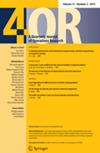钛磁铁矿精矿分级分选的精细水力筛选
IF 2.6
4区 管理学
Q3 OPERATIONS RESEARCH & MANAGEMENT SCIENCE
引用次数: 2
摘要
本文介绍了精细液压筛选在最后磨矿阶段上游钛磁铁矿精矿阶段分离中的应用,并对其工艺效率方案进行了评估。在试验的所有筛分操作方式中,下筛铁的质量分数均高于上筛铁的质量分数,但未能达到精矿61%的目标值。因此,必须对过细颗粒进行额外的磁浓缩。通过细筛对精矿进行分级分离,既可以提高选矿厂的性能(提高10%),也可以在不改变磨矿设备体积的情况下提高选矿厂的工艺指标。在这种情况下,小尺寸的产量平均为55%。在恒定的工艺参数和稳定的工厂性能下,采用精细筛选的分级精矿分离技术,相对而言,可以减少三级磨的体积,不超过操作中未分级产量的一半,即65 - 70%。为获得所要求的精矿品位,必须保证筛料中铁和-0.071 mm级的质量分数的最小允许值。这些指标的值取决于矿石的物质组成和所用的浓缩过程。本文章由计算机程序翻译,如有差异,请以英文原文为准。
Fine hydraulic screening for staged separation of titanium-magnetite concentrate
This article covers the applications of fine hydraulic screening for the staged separation of titanium-magnetite concentrates upstream of the last grinding stage and provides an evaluation of its process efficiency options for the Kachkanarsky GOK. In all screen operating modes tested, the mass fraction of iron in the undersize was higher than its mass fraction in the oversize, but failed to reach the target value for the concentrate of 61 %. Therefore, the undersize must be subjected to additional magnetic concentration. Staged separation of the concentrate by fine screening allows either to improve concentrator performance (by up to 10 %) or to increase the concentration process indicators without changing the grinding equipment volume. In this case, the undersize yield averages 55 %. The use of the staged concentrate separation technology with fine screening at constant process parameters and steady factory performance allows reducing the tertiary mill volume in relative terms, not exceeding half of the undersize yield from the operation, which shall be 65–70 %. The minimum permissible values of the mass fraction of iron and of the –0.071 mm class in the screen feed and the undersize must be ensured for obtaining the required concentrate grade. The values of these indicators depend on the material composition of the ore and the concentration process used.
求助全文
通过发布文献求助,成功后即可免费获取论文全文。
去求助
来源期刊

4or-A Quarterly Journal of Operations Research
管理科学-运筹学与管理科学
CiteScore
3.80
自引率
5.00%
发文量
26
审稿时长
6 months
期刊介绍:
4OR - A Quarterly Journal of Operations Research is jointly published by the Belgian, French and Italian Operations Research Societies. It publishes high quality scientific papers on the theory and applications of Operations Research. It is distributed to all individual members of the participating societies.
 求助内容:
求助内容: 应助结果提醒方式:
应助结果提醒方式:


